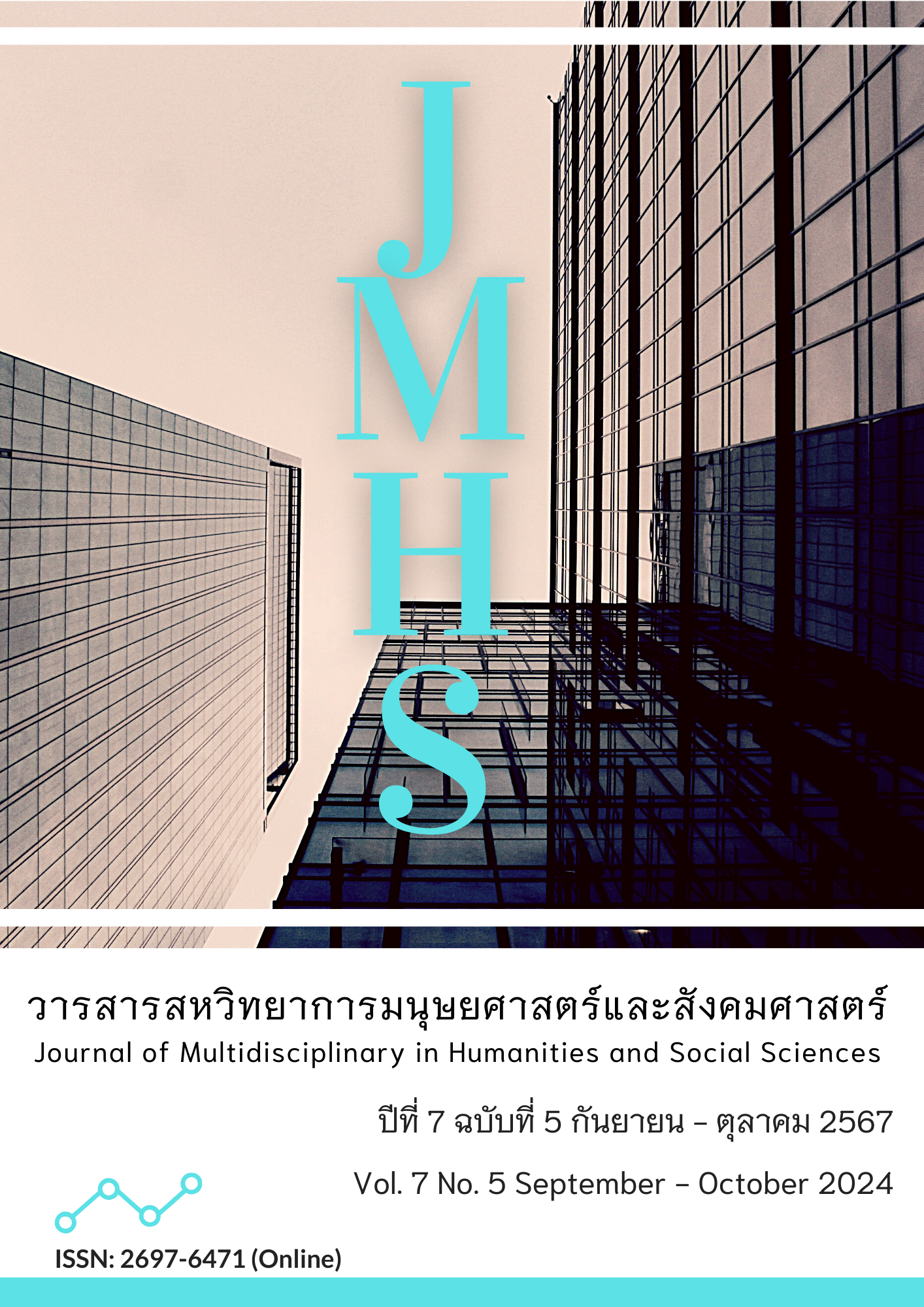Design and Implementation of a Learning Model via VRT for Amplifying Interpersonal Communication Skills among Undergraduate Students
Main Article Content
บทคัดย่อ
International organizations such as the Organization for Economic Cooperation and Development (OECD) and many education experts believe that communication skills are one of the most important for undergraduate students. Good communication skills are crucial for their healthy growth, social adaptation, and career success. However, the current status of communication skills for Chinese undergraduates is not optimistic; therefore, researchers are trying to develop a virtual contextual learning model to improve students’ communication skills. This paper aimed to study (1) the definition of communication skills and their components; (2) the development of a learning model through virtual reality technology (hereinafter referred to as VRT) to improve communication skills; and (3) the effectiveness of the learning model in improving undergraduate students’ communication skills as assessed through VR testing. This study was quantitative research. A sample of this study consisted of 50 students in Class 1 of the 2023 undergraduate law major at the School of Political Science and Law, Zhoukou Normal University, Henan Province. The multi-stage sampling method selected them, and the questionnaire on communication skills of college students served as the collection tool. The researchers reviewed the literature on communication theory, VR theory, problem-based learning theory (hereinafter referred to as PBL), and constructivist theory and designed a learning model based on VRT by combining the results of semi-structured interviews with five teachers. After the experiment concluded, the researchers analyzed the data using a combination of descriptive statistics and content analysis. The results of the study were as follows:
1. Undergraduate students’ communication skills refer to the ability necessary for them to exchange information with others in a comprehensive manner through verbal and nonverbal means in order to establish good interpersonal relationships smoothly and effectively. The main components of Chinese undergraduates' communication skills were their ability to express, listen, understand, and control emotions.
2. Based on VRT theory, PBL learning theory, and constructivist theory, a learning model related to communication skills can be constructed.
3. The learning model constructed in this study was effective in improving undergraduate students’ communication skills.
Article Details

อนุญาตภายใต้เงื่อนไข Creative Commons Attribution-NonCommercial-NoDerivatives 4.0 International License.
ทัศนะและความคิดเห็นที่ปรากฏในวารสาร ถือเป็นความรับผิดชอบของผู้เขียนบทความนั้น และไม่ถือเป็นทัศนะและความรับผิดชอบของกองบรรณาธิการ
เอกสารอ้างอิง
Azevedo, R. (2018). Using hypermedia as a metacognitive tool for enhancing student learning? The role of self-regulated learning. In Educational psychologist (pp. 199-209). Routledge.
Dakhi, O., JAMA, J., & IRFAN, D. (2020). Blended learning: A 21st century learning model at college. International Journal of Multi Science, 1(8), 50-65.
Eggen, P., & Kauchak, D. (2012). Strategi dan Model Pembelajaran. Mengajarkan Konten dan Keterampilan Berpikir. Translated by Satrio Wahono. Jakarta: Indeks. 2012.
Gao, Z.P. (2022). The current situation and comparative analysis of virtual reality majors in Chinese and American Universities. Advancements in Education, 12, 5225.
Gong, X. (2019). A survey on interpersonal communication skills of master’s students in science and engineering(Master’s), Huazhong University of Science and Technology.
Hmelo-Silver, C. E. (2004). Problem-based learning: What and how do students learn?. Educational Psychology Review, 16, 235-266.
Joyce, B.R., Weil, M., & Calhoun, E. (2009). Model of teaching. (8th ed.). Pearson.
Kang, C.P., Xu G.X., Wei, R., Liu, J., Zheng, Y., Liu, Y., Gan Q.L., & Ma, L.H. (2020). Communication literacy: The fourth 5C model of 21st century core literacy. Journal of East China Normal University (Education Science Edition), 38(2), 71-82.
Lai, E., DiCerbo, K., & Foltz, P. (2017). Skills for today: What we know about teaching and assessing collaboration. Pearson.
Liego, M. A. (2022). 21st-Century learning: What it is and why it’s important. TeacherPH. Retrieved September 14, 2022, from https://www.teacherph.com/21st-century-learning/
Olagbaju, O. O., & Popoola, A. G. (2020). Effects of audio-visual social media resources-supported instruction on learning outcomes in reading. International Journal of Technology in Education, 3(2), 92-104.
Organization for Economic Cooperation and Development (OECD). (2019). Future world youth action guide: how PISA assesses global competency. Beijing Normal University Press.
Saputra, F. (2021). Leadership, communication, and work motivation in determining the success of professional organizations. Journal of Law, Politic and Humanities, 1(2), 59-70.
Savin-Baden, M. (2007). Challenging models and perspectives of problem-based learning. In Management of Change (pp. 9-29). Brill.
Tussyadiah, I.P., Wang, D., Jung, T.H., & Tom Dieck, M.C. (2018). Virtual reality, presence, and attitude change: Empirical evidence from tourism. Tourism management, 66, 140-154.
Tyler, R. W. (2013). Basic principles of curriculum and instruction. University of Chicago Press.
Wang, J.Y. (2020). The crisis of interpersonal relationships among college students caused by dormitory conflicts and its solutions. Literary Education (Part 2), 495(1), 164-165.
Xiao, D.L., & Hong,H.C. (2020). Research on VR-supported flipped classroom based on blended learning—a case study in “learning English through news.”. International Journal of Information and Education Technology, 10(2), 104-109.
Yusof, K. M., Sadikin, A. N., Phang, F. A., & Aziz, A. A. (2016). Instilling professional skills and sustainable development through Problem-Based Learning (PBL) among first year engineering students. International Journal of Engineering Education, 32(1), 333-347.


